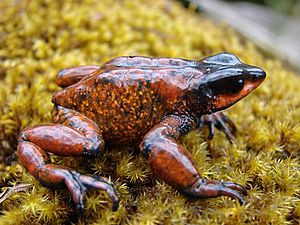Guajira stubfoot toad facts for kids
Quick facts for kids Guajira stubfoot toad |
|
|---|---|
 |
|
| Conservation status | |
| Scientific classification | |
| Synonyms | |
|
Atelopus leoperezii Ruiz-Carranza, Ardila-Robayo & Hernández-Camacho, 1994 |
The Guajira stubfoot toad or Carrikeri harlequin frog (Atelopus carrikeri) is a special type of toad. It belongs to the Bufonidae family, which includes many kinds of toads. This toad is about 5 cm (2.0 in) long. Most of them are black, but some can be orange.
This amazing toad lives only in the Sierra Nevada de Santa Marta mountains in northern Colombia. It is in great danger of disappearing. This is mainly because of a serious frog disease called chytrid fungus. It also loses its home due to habitat destruction from farming. The Guajira stubfoot toad was not seen for 14 years, from 1994 until it was found again in 2008!
Contents
About the Guajira Stubfoot Toad
Naming and Discovery
Scientists first officially described this toad in 1916. A scientist named Alexander G. Ruthven gave it its name. He studied specimens collected by M. A. Carriker Jr. in 1914.
Later, in 1994, another toad was thought to be a new species. It was called Atelopus leoperezii. But scientists later realized it was actually the Guajira stubfoot toad. This toad's closest known relative is Atelopus ignescens, which lives in Ecuador.
What Does It Look Like?
The Guajira stubfoot toad is about 5 cm long. It can have at least two different colors. The orange version is rarer, and this is the one that was recently found again. However, most of these toads are black. Their bellies are usually a slightly lighter shade of black.
Adult toads have smooth skin. But they also have a patch of spiny bumps, like small warts, on their sides. These bumps can cover different areas. On some toads, they go from their eyes to their arms. On others, they go from their eyes to their upper legs (femurs). One toad even had these bumps all over its body!
The Guajira stubfoot toad has short legs. Its fingers and toes are rounded. Its fingers are not connected by webs. But its toes have wide webs between them. Its first toe is easy to tell apart from the others. The toad's head is about as wide as it is long.
Where It Lives and Its Home
This toad lives only in a specific area of northern Colombia. This area is about 627 square kilometers (242 square miles). Its natural homes are mountain cloud forests and high-altitude grasslands called páramo. These areas are found in the Andes mountains.
It can even live in places covered with snow! You can find this toad at very high elevations. It lives between 2,350 and 4,800 meters (about 7,700 to 15,700 feet) above sea level. While it can handle some changes to its home, losing its habitat due to farming is still a big problem.
Life Cycle and Conservation
Reproduction and Young Toads
The Guajira stubfoot toad lays its eggs in long chains. It places these eggs in clear, cold mountain streams. This is where its tadpoles grow and develop.
Why It Needs Our Help
This toad used to be very common. But now, it is in danger of disappearing forever. There are several reasons for this. One big reason is habitat loss. This happens when its home is destroyed for farming. Climate change and spraying crops with chemicals also hurt them.
But the most serious threat is a powerful disease called chytrid fungus. Its scientific name is Batrachochytrium dendrobatidis. Scientists thought this fungus would cause the toad's population to drop by more than 80%.
After not being seen for 14 years, the Guajira stubfoot toad was found again! A team called Project Atelopus rediscovered it in early 2008. They found it in the Sierra Nevada de Santa Marta mountains in Magdalena, Colombia. This rediscovery gives hope for its future.


